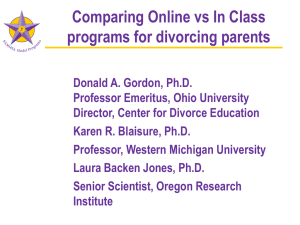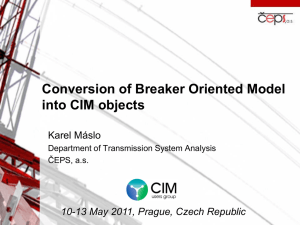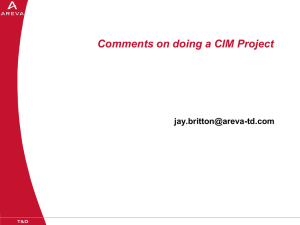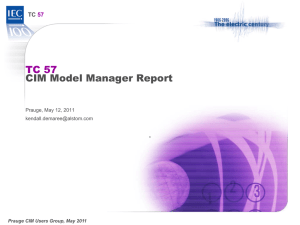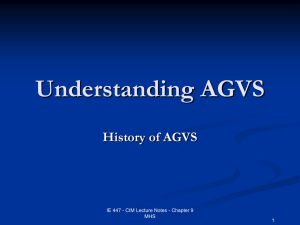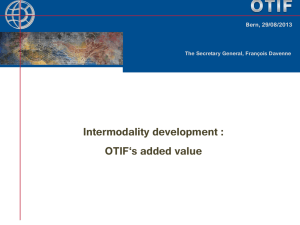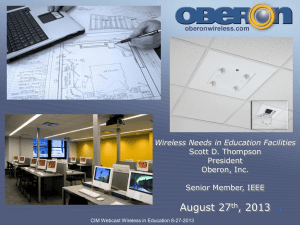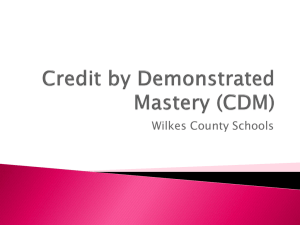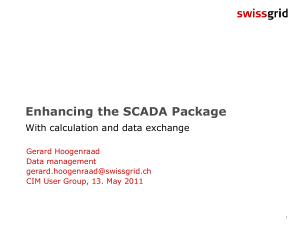Profiles vs the Canonical Model Other (unauthorized
advertisement
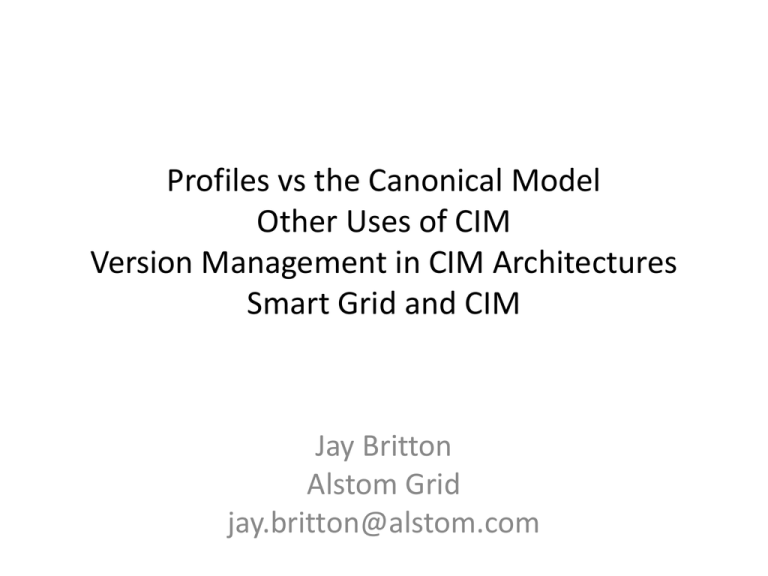
Profiles vs the Canonical Model Other Uses of CIM Version Management in CIM Architectures Smart Grid and CIM Jay Britton Alstom Grid jay.britton@alstom.com CIM Design Center • A rule I learned about applying technology: – Understand the design center of the technology. – Use extreme caution if trying to apply the technology outside its design center. • CIM Design Center – CIM standards aim to simplify integration of components and expand options for supply of components by standardizing information exchanges. • Reduce complexity with clear consistent semantic modeling across the enterprise. • Data sources: achieve a clear picture of data mastership in the enterprise. • Data consumers: make ‘data of record’ available on demand to qualified users. – CIM employs a canonical data model (CDM) strategy for standardizing interfaces in the power system operations and planning domain. What is a Canonical Data Model? CIM Design Center (cont’d) • The CIM CDM is partitioned into sub-domains by IEC WGs. – These groups work hard to maintain a unified semantic model over the whole domain. • The interfaces defined under CIM are defined by profiles. – A profile specifies the information structure of exchanged information by creating contextual semantic models. • Contextual semantic models are a subset of the CIM CDM. i.e. They inherit their structure from the CIM CDM. • Contextual semantic models could contain information not modeled in the CIM CDM. – This is not current CIM practice for standard interfaces. – – – – There is typically a family of related interfaces defined within a profile. Products implement support for profiles. Testing occurs against profiles. CIM compliance is defined against profiles. • There is no such thing as just ‘CIM compliant’. You have to specify the profile. • Do not expect CIM to make sense outside its design center. – If its not needed in a CIM interface, don’t expect it to be in the model. – Don’t expect that CIM is a good database schema. – Don’t expect CIM to make a good class design for your application. Overview of CIM Standards Methodology Canonical Data Model Profiles can be interdependent. CIM CDM CDM Semantic Model Equipment Model Measurement Specification State Variables Topology Analog Meas Set Status Meas Set Contextual Semantic Model Instance Data Analog Set scada Status Set state estimation State Var Meas Spec modeler Equip model topology & scheduling State Var Topology State Var contingency analysis State Var State Var Transformations connect local semantics to standard profile semantics derived from CDM. • Transform issues – – – – Clarity Simple, low cost implementation Maintainability Performance! Producer App Semantic Mdl Transform Spec CIM Contextual Model Transform Spec Consumer App Semantic Mdl Producer App Instance Data Transform Exchanged CIM Standard Data Transform Consumer App Instance Data CIM Evolution • CIM is designed to achieve consistent, high quality models across a large domain. – This mission requires that CIM is able to change as new interfaces are added. – It is not possible to preserve semantic quality if changes are restricted to additions. – At the global CDM level, change is embraced as long as it makes a significant contribution to semantic quality. • Stability may be addressed as appropriate at profile levels. – Profiles are where the investment is made. – Each profile is derived from a version of the CIM CDM, but not the same version. – Changes to CIM do not necessarily require that the profile be updated. – Participants can determine when to update their profile. • About Versioning… – CIM CDM and contextual models will change. – Profiles also change but not in lockstep with the CDM. – Where there are multiple consumers or producers for a profile, it probably is not practical to synchronize upgrades. In the real world, semantic models and standards need to evolve. Version migration within a profile. Using CIM as an Enterprise Model • An enterprise integration strategy based on CIM is a good idea, but... – Recognize that interoperability standards are driving CIM. – Priority issues for standardization are not going to be the same as for your enterprise CDM. • You will need to manage a different version. • Standard CIM will change – and you won’t always appreciate the changes. – If you do not periodically synchronize with the standard, you will inevitably drift away. • This re-sync must be planned for and budgeted! • Recommended practice. – Set up an enterprise information architecture group to maintain your model. – Maintain a harmonization between your model and the standard CIM. • Harmonization: a formal specification for transformation between two CDMs. – Manage transformation implementations. • This is where a lot of life-cycle cost is centered. • You may think that CIM is complex. • From the standpoint of one information exchange implementation, it is. • If you compare life cycle of 100 exchanges, each implemented in CIM, against other alternatives, CIM is much simpler. CIM is not the easiest way to do anything – it is the easiest way to do everything!
